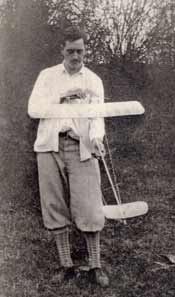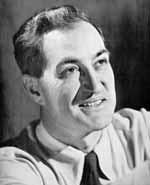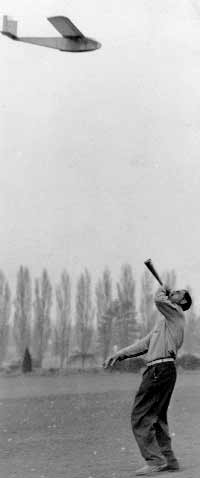
Memories of Jim Walker
from AIR TRAILS magazine - May, 1950
The first part of this story can be found on our Ceiling Walker page.
 To the A-J Aircraft firm, models like the Ceiling Walker are an old story. It really began in 1926 when young Jim, then building models in his basement, first organized "A-J." While this may suggest fhat the energetic Walker is no spring chicken, top flight modelers doff their hats to the man from Mars (pardon— Portland) when it comes to flying technique. The high degree of coordination required when he flies simultaneously three Fireball models by his Remoto control so far confounds all. To these contest modelers Walker means the sabre dance with a Fireball, radio-control stunting and, of course, he is the papa of U-control. But through the years Walker has meant something entirely different to hundreds of thousands of kids who had their first modeling experience with his ready-to-flys. His name they may not have known, but with his products they were quite familiar.
To the A-J Aircraft firm, models like the Ceiling Walker are an old story. It really began in 1926 when young Jim, then building models in his basement, first organized "A-J." While this may suggest fhat the energetic Walker is no spring chicken, top flight modelers doff their hats to the man from Mars (pardon— Portland) when it comes to flying technique. The high degree of coordination required when he flies simultaneously three Fireball models by his Remoto control so far confounds all. To these contest modelers Walker means the sabre dance with a Fireball, radio-control stunting and, of course, he is the papa of U-control. But through the years Walker has meant something entirely different to hundreds of thousands of kids who had their first modeling experience with his ready-to-flys. His name they may not have known, but with his products they were quite familiar.
Walker's approach differs radically from that of the remainder of the industry, for there are some who consider anything that does not have to be put together as a toy. You can argue this point till doomsday without reaching an answer but, anyway, the Walker idea has fathered an entertaining series of models. Many present day senior and open claw competitors recall the Martin bomber all-balsa profile glider which cost no more than a fat lollypop and gave twice the satisfaction. Printed details were done in color and were startling in their realism; the wings were dihedraled and cambered and you just pushed them through a. slot. Another number was the single-engine Fairchild amphibian type—another profile, complete to aluminum nacelle and free-wheeling three-bladed metal propeller.
Like many .other modelers of the pre-Lindbergh era. Walker was thoroughly in love with aviation. That meant reading books about it and going out to the airport to stare at the biplanes and their glamorous pilots. Besides making models, of course. Inevitably, Walker got around to making a man-carrying glider. After a particularly rough landing he decided it would be a nice feature to add a motor. So he made several ships equipped with motorcycle engines. Then someone bet him $5 he couldn't make a model plane fly for 200 feet. After Jim collected the foolish five, he went into the model business. Boys came in after school to man the production line. By the time Lindy reached Paris twenty-three years ago, Jim had a 40-man payroll. Just as "A-J" expanded into a corporation, the Japs flooded the market with paper, cardboard and soldered-wire ready-to-fly models and the bottom dropped out of the business. So Walker loaded his car with samples, stuck a golf bag on top, and sallied forth to do battle with the buyers.
Whenever he entered a strange office he'd conceal his business and beat the buyer to the punch by tossing a glider in the general direction of the august personage. The glider would then circle around the man's head and come back to roost in Jim's hand. Before the tycoon could recover his wits, another glider was on the way, then still another, until a steady stream buzzing around his head made him feel like a pylon at the National Air Race. Then. came the clincher. "Any boy over seven years of age can do the same thing. This littlee glider will do 19 different tricks and it retails for a nickel."
Stories like this have made Walker a legend. Even his mistakes turn out well. Once he launched a plane to impress a buyer but the model sailed out an open window. Before the buyer figured out what was going on, it reappeared through another window. Jim got a big, order.
 Incorporated in 1929 with a couple of money bags for angels, A-J finally came into the hands of Jim and brother Lawrence in 1936 when the original backers were bought out. Moved to its present quarters, A-J blossomed into a three-shift manufacturing business that sometimes operated, for weeks. without a breathing spell. Then the Fireball was created by Walker—and U-control was on the way. With the stubborn resistance of the free-flight contest world to the radical "models on a string," Walker again rode endlessly to contests. Inviting anyone and everyone to fly a Fireball with him by dual controls. Just when the Fireball began to go over, came the war: no materials.
Incorporated in 1929 with a couple of money bags for angels, A-J finally came into the hands of Jim and brother Lawrence in 1936 when the original backers were bought out. Moved to its present quarters, A-J blossomed into a three-shift manufacturing business that sometimes operated, for weeks. without a breathing spell. Then the Fireball was created by Walker—and U-control was on the way. With the stubborn resistance of the free-flight contest world to the radical "models on a string," Walker again rode endlessly to contests. Inviting anyone and everyone to fly a Fireball with him by dual controls. Just when the Fireball began to go over, came the war: no materials.
Walker and his engineers beat out their brains tor some way to contribute to the war effort and remain in business. But anyone with Walker's brains and luck never remains tor long behind the eight ball. This time fate, in the person of an army major, walked into a Texas five-and-dime store, picked up an Interceptor glider and said. "This is what we need."
Before long the orders cascaded in. What did the army want the gliders for? To shoot at, of course. With a special catapult the Interceptors were shot 300 feet into the air at which altitude they appeared to ground gunners as a 300-mile-an-hour fighter at 1,500 feet.
Although more than 125,000 of these training aids were produced, the actual output at Walker's factory was small in comparison to peace time production, and all sales were made at considerable loss.
Walker, a mild mannered chap who gets eccentric where models are concerned, is really a turmoil of ideas and things to do. The end products of his idea machine are divided about evenly "between models and new ways to fly them. Besides the flying models, there is the U-control patent, the U-Reely reel-handle, a fuel flow device for U-Control models that automatically adjusts the mixture to eliminate rich starts and leaned-out flights, a variable pitch propeller and, soon to be on the market, his radio-control system. Walker demonstrates these things any-where, anytime, at the drop of a hat
A certain New York jobber will never forget the time that Walker showed him how a Fireball would loop—this in front of the central post office, probably the biggest one in the world. The result was one of the wildest traffic jams in city history. People even climbed on top of cars to see the show. It took the riot squad to restore order. Later, in Chicago, Walker was affronted when the windy city sent a lone motorcycle cop to investigate the disturbance. Walker taught the cop how to "fly the model and all went well until the control wires wrapped around the law.
 Walker's research is a serious business that brooks no obstacles. When he was developing his sonic glider, Jim decided to find out what noises were most effective in controlling the plane. Loading himself down with drums, whistles, and all available noise-making devices, including a .22 caliber pistol, he started down the street. He would beat the drum and pause. Then blow a whistle. Pause. Finally, in an open lot be fired the gun into the air. Just then the police arrived in a cloud of dust, summoned by neighbors who thought Walker had finally cracked. But when Jim explained his problems to the policemen and how the .22-really didn't make enough noise, an obliging officer hauled out his "45" and began to blast.
Walker's research is a serious business that brooks no obstacles. When he was developing his sonic glider, Jim decided to find out what noises were most effective in controlling the plane. Loading himself down with drums, whistles, and all available noise-making devices, including a .22 caliber pistol, he started down the street. He would beat the drum and pause. Then blow a whistle. Pause. Finally, in an open lot be fired the gun into the air. Just then the police arrived in a cloud of dust, summoned by neighbors who thought Walker had finally cracked. But when Jim explained his problems to the policemen and how the .22-really didn't make enough noise, an obliging officer hauled out his "45" and began to blast.
With the exception of the" Fireball, still a reasonably prefabricated kit in this day of ultra prefabrication, A-J is not in the kit business, but is primarily concerned with simple ready-to-fly models.
AIR TRAILS PICTORIAL - May, 1950
Writer is unknown
Home | Jim Walker | FireWire | Air Mail | Notices | Workshop | Short Takes | Fireball | Firebaby | A-J Store